If earlier stage performances only entertained children, nowadays the theater is used to improve imagination, speech skills and fine motor skills, as well as to instill in the baby an artistic taste. When and how should children be introduced to the magical world of art?
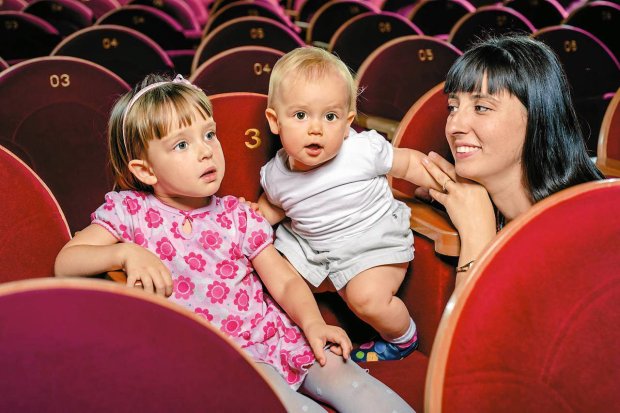
The first acquaintance of the baby with the "stage" occurs at home - with the help of dolls. Such performances help children to live situations, trying on various behaviors and choosing the only right one. A re-enactment will help in case of psychological trauma. That is why experts advise adults to play with the child in a "kindergarten" before visiting a kindergarten or in a "doctor" - on the eve of going to the hospital. Theatrical games enrich the child’s vocabulary, develop imagination and enable mom and dad to educate him without boring notations.
When to start?
Some parents think that children can be introduced to the culture from any age. However, this is not quite the right opinion. A long road, a crowded place, a constant noise will not only tire the little kids, but also stop the hunt for further visits to the Youth Theater. And even the most pleasant emotions received from a short performance (no more than half an hour) will not outweigh such discomfort.
Overly impressionable children are often afraid of scary heroes: Babu Yagu, Koshchei, Zmety Gorynych, the Gray Wolf, etc. Therefore, in some theaters they prefer to acquaint kids with actors who play negative characters before the show. Seeing them in makeup, even the most emotional young audience will remain calm.
Finger performances
Starting from a year and a half, your offspring will be able to enthusiastically watch the performance, which is played with the help of parents or their own fingers. The necessary props can be done by yourself (for example, sew ears on each finger of a garden glove and draw a face on them) or purchase them in a children's store.
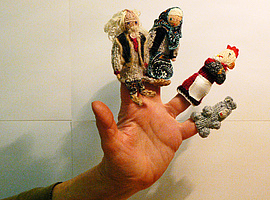
For the literary basis, take a fairy tale that is well known to the child (“Kolobok”, “Teremok”, “Kurochka-Ryaba”), re-read it again, show the illustrations and, finally, distribute the main roles. At first, children's attention will not be enough for the whole performance and after 5-10 minutes the baby will be distracted by the toys themselves. Accustomed, he will gladly respond to the actions and emotions of the characters.
Plane theater
Children older than three or four years old can easily be interested in board scenes - a game with cardboard or plywood silhouettes on stands.For this type of "dramaturgy" you will need figures painted on both sides, a variety of decorations: houses, clouds and trees, animals and birds. The kid will be happy to voice all the fairy-tale characters, inventing each character's own unusual voice. Such a variety will remarkably develop his speech and phonemic hearing.
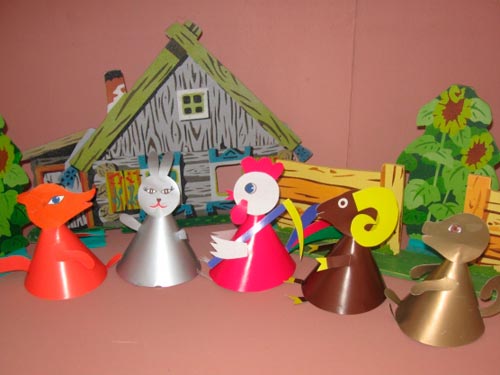
Another option for such performances is the cone theater. You can make characters yourself or download schemes from the Internet. All you need to do is cut out geometric shapes and glue them together. Your children will definitely help you with this. Dolls turn out to be bright and voluminous, and for greater persuasiveness they can be decorated with paper fringe, sparkles.
Puppet show
For older children who have already mastered the ability to conduct dialogue and act in accordance with the plot, you can play with dolls. Ordinary toys, glove dolls (in the old days they were called parsley) or even puppets, as well as a screen, will come in handy. Doll gloves behave like a real person: they meet, hug, dance, sing songs, quarrel and make peace. Explain the basic rules to the preschooler: the index fingers command the character’s head, and the large and medium fingers command his hands.
READ ALSO: Home Puppet Theater - a fun journey into the fairy world
Tips for parents to leave the child in the theater
So, the time has come for a real theater! If you want only good impressions from your first visit, you need to carefully choose the repertoire based on the age of your child and his preferences. What do you need to remember?
- For debut viewing, select a puppet show based on a popular fairy tale. Give preference to the classic setting, since the peanut often knows your favorite stories by heart and may not understand the bold directorial decision.
- Acquaintance with art is best started with a chamber theater. A not very large room, muffled music create an almost homely atmosphere. In such cultural institutions there is no mass crowd and loud noise characteristic of huge buildings.
- For mobile children, on the contrary, interactive productions arranged by holiday agencies at home or in kindergarten are suitable. If your offspring is shy and does not want to take part in the general game, do not insist. Let him be ordinary observers for now.
- Make sure that viewing the production does not violate the usual routine. Do not buy tickets for a day session if your baby is used to sleeping after dinner. Also, refuse additional entertainments: a trip to a cafe or to an amusement park is better to be rescheduled for another day.
- Be prepared for the fact that the cult trip may end in whims or even tantrums. Outsiders, an excess of impressions, prohibitions and new rules of behavior - all this is too complicated for small theatergoers. Do not be angry, better calm the baby, talk and find out what he remembers the most.
- Come on the day of the show in advance. Then you will have time to walk around the building, carefully consider the different exposure. Try to enrich preschool vocabulary with new words: stage, makeup, intermission, wardrobe, etc. If your child gets tired quickly, on the contrary, come immediately before the fabulous action, leaving time for the toilet and undressing.
- Do not forget that for children's perception the most difficult are opera and ballet. A child under the age of eight to nine years is able to get bored or fall asleep, looking at dancing or listening to arias for two hours.
- Do not be discouraged if your children will remember not a performance, but only a visit to the buffet. For them, this event is one huge holiday, and let them get positive emotions from at least a delicious ice cream.
- When the baby rests and calms down, lose what you saw for the teddy bear or grandmother. Draw bright scenery, fashion characters from plasticine.Re-read the literary work that formed the basis of the performance, and at the same time read other tales of the same author.
Undoubtedly, many more trips to the Temple of Melpomene await you, but the very first visit will remain in children's memory for a long time. Prepare your offspring for this wonderful world, and then he will grow up a cultured man who loves the scene and the bright light of spotlights.
Doctor of pedagogical sciences, professor of NGPU Irina Shulga - about the age at which it is best to introduce children to the theater.

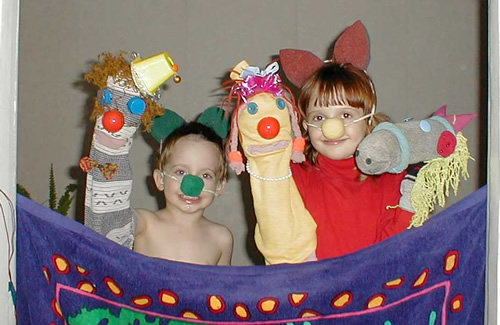






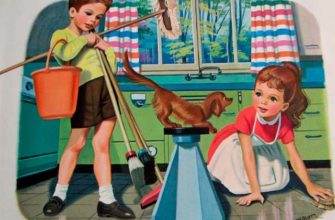

Thanks for the article, I was just asking this question, I have a daughter of 1.5 years. I'll start to prepare)